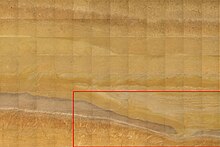Lacquer print

A lacquer removal (also called lacquer profile, lacquer film, soil profile , soil layer image, sediment transfer preparation) is the result of a process that enables the lifelike recovery of loose rock ( e.g. gravel , sand , silt , clay ), but also peat with clearly visible sedimentological , tectonic , archaeological or paleontological traces allowed. The removal of lacquer profiles from soils with larger stones, with higher stone contents or with water-saturated peat or artefacts is often difficult; the so-called box profile method is often preferred there.
description
A lacquer print faithfully reproduces a section of the diverse geological deposits in loose sediments , but in a mirror image . In elaborate work steps, thin but true-to-color, structured and plastic layers of a slope section are prepared with the help of synthetic resins and lacquers and permanently fixed on a solid base. Due to the special lacquers that are now available and the refinement of the work steps, the method developed to today's perfection.
The technique of lacquer deduction was around 1930 by the geologists and paleontologists Ehrhard Voigt for the recovery of vertebrate - Fossils of Geiseltal in Halle (Saale) developed; Voigt himself called it the paint film method . A photographic documentation is not able to reproduce important geological facts, which can extend into the microscopic range, so impressively and without distortion.
“Today, geoscientific documentation is no longer just about collecting and storing fossils, minerals and rocks . The profile walls of our outcrops, which are often only temporarily accessible, are important geological documents that need to be recovered and preserved, ”said Ehrhard Voigt on the occasion of the Geo-Documenta 1975 in Braunschweig .
This applies in particular to the mostly short-lived embankments exposed in sand and gravel pits with their geological and pedological shapes and structures. In an overview that often goes far back in geological history, these localities constantly reveal new images of geological history . In order to record these unique traces of the past, scientists, taxidermists and committed private individuals started geoscientific documentation by means of varnish prints years ago.
The lacquer prints going back to Ehrhard Voigt are also used to secure fingerprints.
Largest geo-historical varnish print

The largest geo-historical paint print was made in 2005/2006 by Ulrich Lieven and Jürgen Bläser in the Garzweiler opencast mine of RWE Power AG. Among other things, it shows the dark brown band of an Eemzeit soil, which was the surface of the earth at the time of the Neanderthals . The entire lacquer print is 12 m wide and 8 m high and was made in 96 tiles, each 1 m² in size. The reason for this work was the exhibition "Roots - the roots of mankind", which from July to November 2006 in the Rheinisches Landesmuseum Bonn showed the most important finds of prehistoric humans in the original.
A large section (8 × 3 m) of this lacquer print was given to the North Rhine-Westphalia Geological Service in Krefeld on permanent loan in August 2007. The exhibit can be viewed there.
Another method of preserving soil profiles is the box profile. In this case, soil columns (soil monoliths) are first removed from the terrain with a (wooden) box. The drying takes place in the laboratory. Then the floor is impregnated with varnish, glued to a wooden plate and then the floor structure is prepared. Almost all more or less cohesive soils are suitable for this. Stony soils are a particular challenge. With this method the soil structure can be worked out very well, especially with larger soil aggregates. A disadvantage is that the removed monoliths - depending on their size - are very heavy. In addition, the processing takes longer than with other methods (among other things because of the drying of the monolith).
In modern art , lacquer prints are increasingly being made and offered as independent works of art.
literature
- E. Voigt: The application of the paint film method in the recovery of geological and pedological profiles . - Messages from the Geological State Institute Hamburg 1940
- Hähnel: The paint film method for preservation geolog. Objects . - The Taxidermist, 7, 1961
- Geo-Documenta: Lacquer prints . - Geology-Soil Science-Archeology, Braunschweig 1975
- U. Lieven: 20 years of geological documentation in the lignite tertiary of the Lower Rhine Bay. Sediments, paint prints, observations. documenta naturae, special volume 43, Munich 2006, ISBN 3-86544-543-8
- M. Obermöller: Soil makes history. Lacquer profiles - decals from the earth's history. Darmstadt 2007, ISBN 978-3-89678-995-2
Web links
- Brochure on the technology of paint profiling from the International Soil Museum, Wageningen (PDF; 1.3 MB)
- Extensive documentation on the project Largest varnish print in geographic history
- Geological Service North Rhine-Westphalia, Krefeld, paint profile collection: poster for the production of paint profiles and the largest paint profile
- Photos and video of the manufacture of lacquer profiles
- A remarkable collection of lacquer profiles from all over the world
